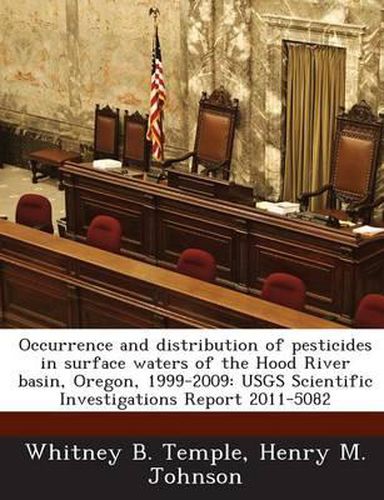Readings Newsletter
Become a Readings Member to make your shopping experience even easier.
Sign in or sign up for free!
You’re not far away from qualifying for FREE standard shipping within Australia
You’ve qualified for FREE standard shipping within Australia
The cart is loading…






The U.S. Geological Survey analyzed pesticide and trace-element concentration data from the Hood River basin collected by the Oregon Department of Environmental Quality (ODEQ) from 1999 through 2009 to determine the distribution and concentrations of pesticides in the basin’s surface waters. Instream concentrations were compared to (1) national and State water-quality standards established to protect aquatic organisms and (2) concentrations that cause sublethal or lethal effects in order to assess their potential to adversely affect the health of salmonids and their prey organisms. Three salmonid species native to the basin are listed as “threatened” under the U.S. Endangered Species Act: bull trout, steelhead, and Chinook salmon. A subset of 16 sites was sampled every year by the ODEQ for pesticides, with sample collection targeted to months of peak pesticide use in orchards (March-June and September). Ten pesticides and four pesticide degradation products were analyzed from 1999 through 2008; 100 were analyzed in 2009. Nineteen pesticides were detected: 11 insecticides, 6 herbicides, and 2 fungicides. Two of four insecticide degradation products were detected. All five detected organophosphate insecticides and the one detected organochlorine insecticide were present at concentrations exceeding water-quality standards, sublethal effects thresholds, or acute toxicity values in one or more samples. The frequency of organophosphate detection in the basin decreased during the period of record; however, changes in sampling schedule and laboratory reporting limits hindered clear analysis of detection frequency trends. Detected herbicide and fungicide concentrations were less than water-quality standards, sublethal effects thresholds, or acute toxicity values. Simazine, the most frequently detected pesticide, was the only herbicide detected at concentrations within an order of magnitude (factor of 10) of concentrations that impact salmonid olfaction. Some detected pesticides are of concern, not for their toxicity alone, but for their ability to potentiate the harmful impacts of other pesticides, particularly organophosphates, on salmonids or their prey. Many samples contained mixtures of pesticides, but the effects to salmonids of relevant mixtures at environmentally realistic concentrations for the basin are unknown. Trace-element concentration data, although limited, indicate that eight trace elements are also of concern for their potential to harm salmonid health. The dataset is limited with regard to the spatial and seasonal distribution of pesticides and trace elements in all salmonid-bearing streams, the presence of particle-bound pesticides, and the presence of several unmonitored pesticides known to be used in the basin.
$9.00 standard shipping within Australia
FREE standard shipping within Australia for orders over $100.00
Express & International shipping calculated at checkout
The U.S. Geological Survey analyzed pesticide and trace-element concentration data from the Hood River basin collected by the Oregon Department of Environmental Quality (ODEQ) from 1999 through 2009 to determine the distribution and concentrations of pesticides in the basin’s surface waters. Instream concentrations were compared to (1) national and State water-quality standards established to protect aquatic organisms and (2) concentrations that cause sublethal or lethal effects in order to assess their potential to adversely affect the health of salmonids and their prey organisms. Three salmonid species native to the basin are listed as “threatened” under the U.S. Endangered Species Act: bull trout, steelhead, and Chinook salmon. A subset of 16 sites was sampled every year by the ODEQ for pesticides, with sample collection targeted to months of peak pesticide use in orchards (March-June and September). Ten pesticides and four pesticide degradation products were analyzed from 1999 through 2008; 100 were analyzed in 2009. Nineteen pesticides were detected: 11 insecticides, 6 herbicides, and 2 fungicides. Two of four insecticide degradation products were detected. All five detected organophosphate insecticides and the one detected organochlorine insecticide were present at concentrations exceeding water-quality standards, sublethal effects thresholds, or acute toxicity values in one or more samples. The frequency of organophosphate detection in the basin decreased during the period of record; however, changes in sampling schedule and laboratory reporting limits hindered clear analysis of detection frequency trends. Detected herbicide and fungicide concentrations were less than water-quality standards, sublethal effects thresholds, or acute toxicity values. Simazine, the most frequently detected pesticide, was the only herbicide detected at concentrations within an order of magnitude (factor of 10) of concentrations that impact salmonid olfaction. Some detected pesticides are of concern, not for their toxicity alone, but for their ability to potentiate the harmful impacts of other pesticides, particularly organophosphates, on salmonids or their prey. Many samples contained mixtures of pesticides, but the effects to salmonids of relevant mixtures at environmentally realistic concentrations for the basin are unknown. Trace-element concentration data, although limited, indicate that eight trace elements are also of concern for their potential to harm salmonid health. The dataset is limited with regard to the spatial and seasonal distribution of pesticides and trace elements in all salmonid-bearing streams, the presence of particle-bound pesticides, and the presence of several unmonitored pesticides known to be used in the basin.